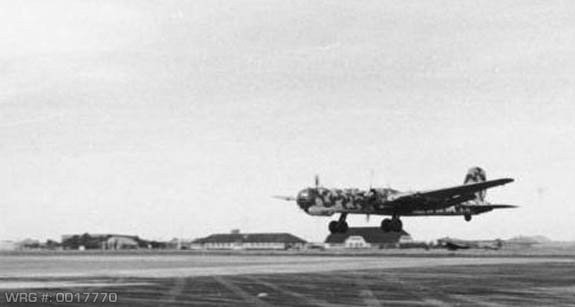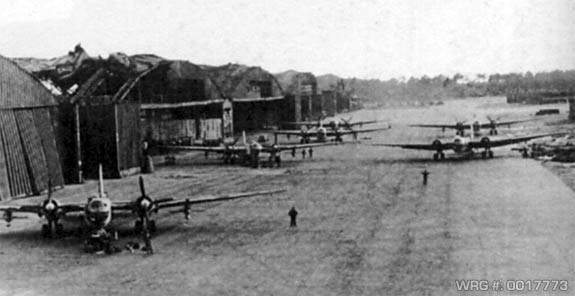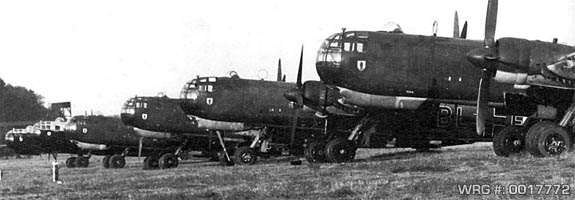LUFTWAFFE RESOURCE CENTER > BOMBERS > HEINKEL He 177 > PREVIOUS PAGE
HEINKEL He 177
Operational History
Beset by technical difficulties in development, the He 177 had a troubled service. Overly optimistic design requirements of long range, high speed, heavy bombload, and dive bombing didn't help. Although the He 177 entered service in 1942 it was far from operational. In an assessment of the aircraft on April 9, 1942 the newly activated Erprobungsstaffel 177 reported that the Greif had good flying characteristics, but had unacceptable engine troubles and deficits with the airframe strength. As an emergency measure it was used to supply the encircled 6th Army at Stalingrad where it was found to be unsuited for the transport role, carrying a little more cargo than the smaller, more reliable Heinkel He 111, and was useless for the evacuation of wounded. As a result the He 177s reverted to bombing and flak-suppression missions near Stalingrad. Only thirteen missions were flown and seven He 177s were lost to fire without any action attributable to the enemy.

A He 177 taking off, 1944.
[Source: Bundesarchiv, Bild 101I-676-7972A-04/Blaschka/CC-BY-SA]
As the war progressed, He 177 operations became increasingly desultory. Fuel and personnel shortages presented difficulties, and He 177s were sitting on airfields all over Europe awaiting new engines or engine related modifications. During Operation Steinbock, of the 14 He 177 sent out, one suffered a burst tire, 8 returned with overheating or burning engines and of the 4 that reached London one was lost to night fighters. These aircraft were brand new, delivered a week before the operation and not fully flown-in, as the air unit had moved to a new airfield the day before and lacked sufficient maintenance personnel and material. Constant attacks against Luftwaffe long range combat units in France made continuous operations difficult.

He 177s of II/K.G.40 being prepared for an attack. Five of the bombers carry glider-bombs, one under each outer wing. The airfield is at Bordeaux/Merignac.
[Source: Unknown]
While Steinbock was unsuccessful, the He 177 did achieve some successes. They typically carried two 1,800 kg (3,970 lb) and two 1,000 kg (2,200 lb) bombs. Climbing to 7,000 m (22,965 ft) while still over German territory, the He 177s approached the target in a shallow dive, each aircraft throttled back, the pilot putting his aircraft into a gliding descent to take it across the bomb release-point at about 4,500 m (14,760 ft). After releasing the bombs the pilot re-opened the throttles, but continued the descent at approximately 200 m (656 ft) per minute. The bombers typically re-entered German airspace at an altitude of 750 m (2,460 ft), and headed back to base. By such means, the He 177s were able to keep up speeds of about 600 to 700 kph (370 to 430 mph) during their withdrawal phase. The higher speed and constant change of altitude made interceptions difficult, increasing the survivability of the aircraft, but decreased accuracy. With an average loss rate of 60% for all types of
bomber used in Operation Steinbock, the He 177s loss rate below 10% made them the most survivable bomber in the campaign.

A flight line full of Griffons.
[Source: Unknown]
During operations on the Eastern Front in early 1944, often carried out in daylight at about 6,000 m (19,690 ft) or higher, losses were relatively light. The Soviet Air Force, equipped mainly for low-level interception and ground-attack roles, was able to do little to hinder the high-flying bombers.
In common with most German bombers, the He 177 was grounded from the summer of 1944 on as Allied bombing crippled German fuel production. The He 177 can be compared with the
Boeing B-29 Superfortress which also took about two years to have its problems ironed out, after which it found success. However the He 177 was never to achieve its full potential.
Source:
WikiPedia
LUFTWAFFE RESOURCE CENTER > BOMBERS > HEINKEL He 177 > PREVIOUS PAGE



